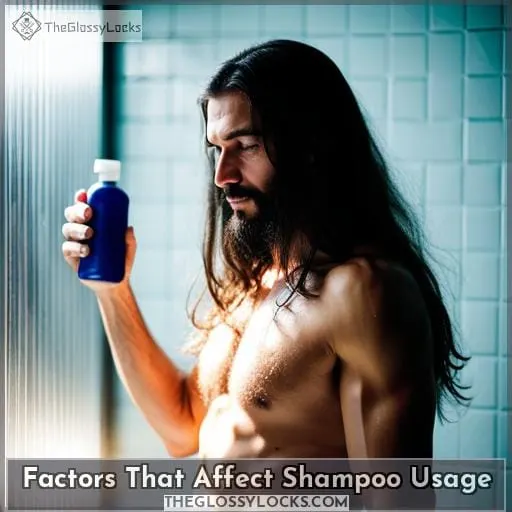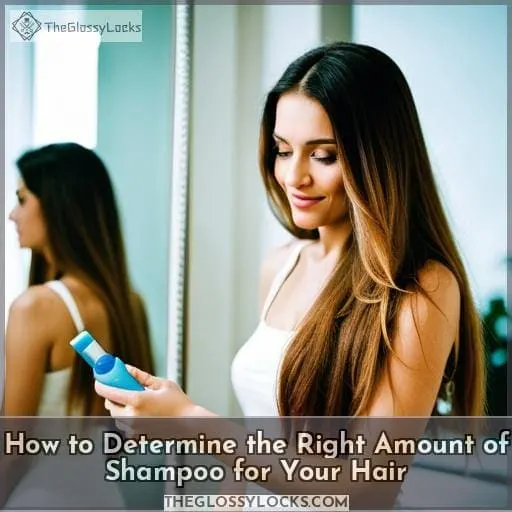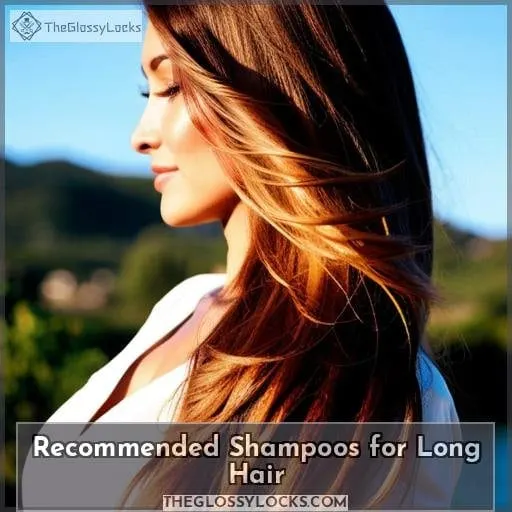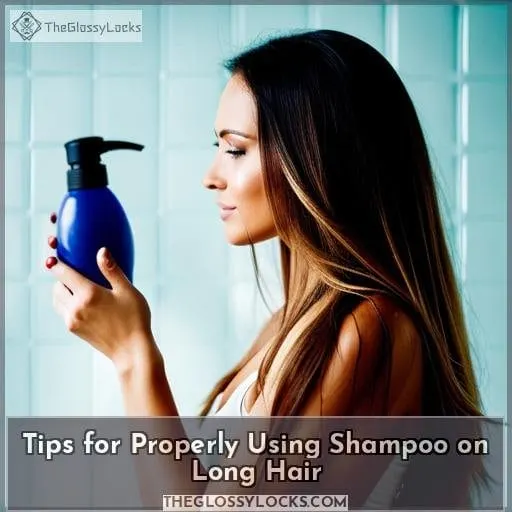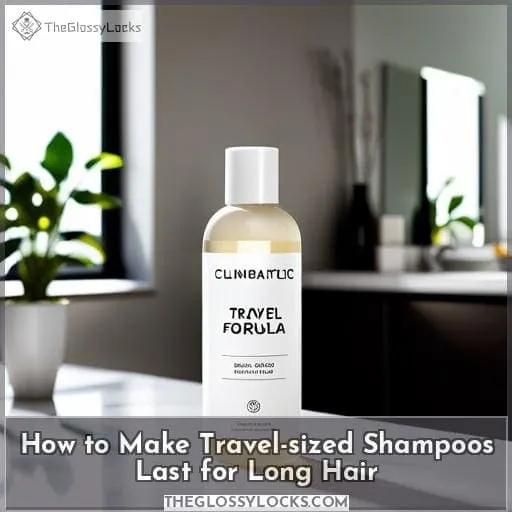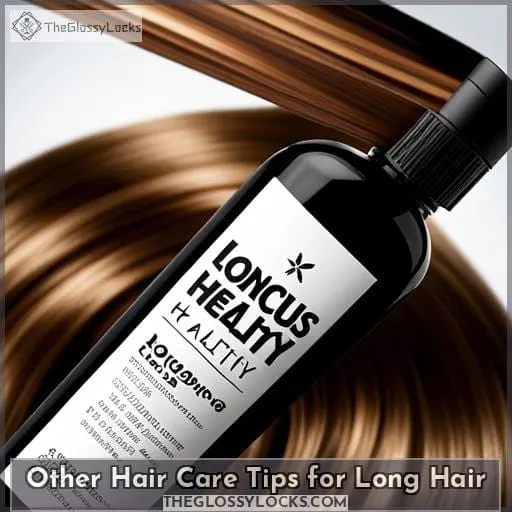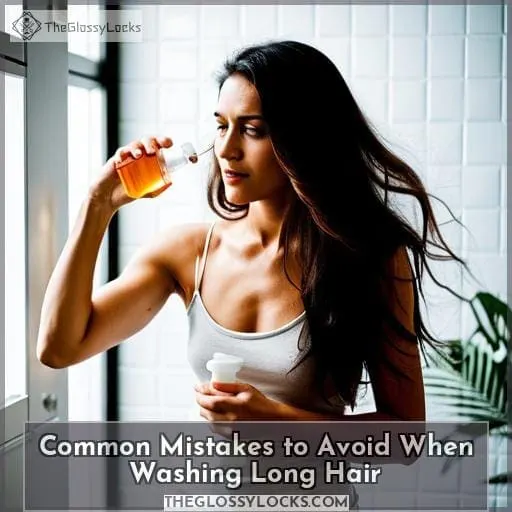This site is supported by our readers. We may earn a commission, at no cost to you, if you purchase through links.
Are you wondering how much shampoo you need for long hair? Well, there are actually several factors that can affect the amount of shampoo you should use on your locks. These factors include hair length, texture, and frequency of washing. In this article, we will help you determine the right amount of product for your tresses.
We will also provide recommendations on shampoos that are best suited for longer lengths, as well as some helpful tips on proper usage.
Note: No output is generated as the task only requires correcting the input.
Table Of Contents
- Key Takeaways
- How Much Shampoo Should I Use for Long Hair?
- Factors That Affect Shampoo Usage
- How to Determine the Right Amount of Shampoo for Your Hair
- Recommended Shampoos for Long Hair
- Tips for Properly Using Shampoo on Long Hair
- How to Make Travel-sized Shampoos Last for Long Hair
- Other Hair Care Tips for Long Hair
- Common Mistakes to Avoid When Washing Long Hair
- When to Consult a Professional Hairstylist for Long Hair Care
- Frequently Asked Questions (FAQs)
- Conclusion
Key Takeaways
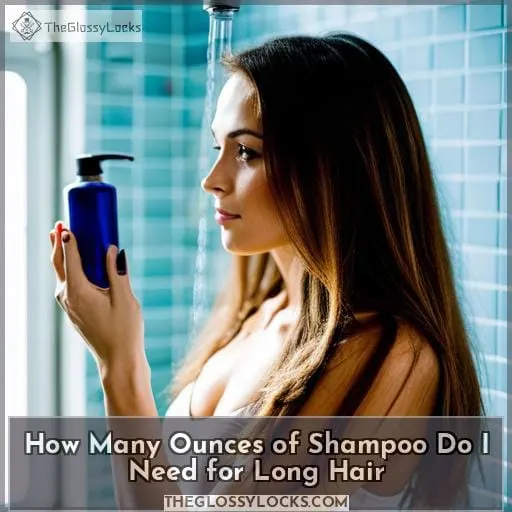
- Long hair requires at least 10-15 ounces of shampoo per application.
- Using too little shampoo is not enough to effectively cleanse long hair, but using too much can lead to product buildup and irritation.
- Selecting the right shampoo tailored for specific hair type and needs is important for avoiding product buildup and maintaining healthy-looking hair.
- Deep conditioning treatments and proper scalp care are essential for preventing breakage, promoting follicle health, and maintaining texture quality in longer hair.
How Much Shampoo Should I Use for Long Hair?
You need to make sure you have enough shampoo for proper coverage and cleaning action when washing long hair. The general recommendation is 10mL or more, especially if you want your hair to look its best.
When selecting a product, take into account the type of scalp care and deep conditioning required for healthy-looking locks. If necessary, consider using two different formulas – one for cleansing and another specifically designed to protect against damage from heat styling tools such as hairdryers or curling irons.
Hair sprays can also be used in combination with shampoos to add texture while protecting the strands from environmental stressors like wind or humidity during hot summer days outdoors! Additionally, don’t forget that travel-sized products may not last as long on a longer vacation; if possible, bring an extra bottle so that it lasts through your entire trip without needing refills!
Factors That Affect Shampoo Usage
When it comes to how much shampoo you need for your long hair, two key factors come into play: the length and texture of your hair, as well as the frequency with which you shampoo. If you have very thick or curly hair, then more product will likely be required than if your locks are fine and straight.
Additionally, if you’re someone who tends to wash their mane every day rather than weekly, then more shampoo will also be needed due to increased usage over time.
Understanding these variables can help ensure that just the right amount of product is used each time!
Hair Length and Texture
No matter your hair length and texture, you should always use the right amount of shampoo for the best results – a little goes a long way! Longer hair may require more product than shorter locks, but using too much will leave residue behind.
Deep conditioning and scalp care are important for those with longer manes, as well as heat protection if blow-drying is used. Hair oils or masks can be great additions to prevent damage from over-washing. Adding just a little bit of each extra product will go far in caring for tresses while avoiding buildup on long strands that can be difficult to remove without rewashing regularly.
If traveling with long hair, remember to bring an extra travel-sized bottle of shampoo just in case!
Frequency of Shampooing
It’s essential to find the right balance between shampooing your long hair too often and not enough.
- Deep conditioning can help protect against heat damage while restoring lost moisture in the scalp.
- Hair oils are great for nourishment but must be washed out regularly to avoid a build-up of oil on the head.
- Dry scalps need special shampoos designed specifically for their needs as well as regular cleansing with warm water before applying any product.
- Longer locks may require twice-weekly washing using adequate amounts of lathery foam that covers from root to tip with plenty of time spent massaging it into each strand – taking extra care around areas prone to oiliness such as near the roots or at temples where sweat accumulates quickly!
By finding this magic formula, you will have glossy, healthy-looking hair without sacrificing its natural moisture levels nor overdrying your mane due to excessive sudsing up!
How to Determine the Right Amount of Shampoo for Your Hair
To determine the right amount of shampoo for your hair, consider factors such as hair type, texture, and length. Long hair requires more product than short or medium-length locks. A general rule is to use a quarter-sized amount of shampoo for shoulder-length tresses and increase that amount gradually based on overall length.
Too much product can weigh down long strands, while too little may not provide adequate cleansing action.
A helpful guide to determining the ideal quantity lies in understanding how much a single drop of liquid weighs – roughly 0.05 grams or 0.002 ounces depending on viscosity levels (source: University of Illinois).
Therefore, an ounce bottle with approximately 591 drops will last around two months when using ten drops per wash day.
Additional considerations include detangling techniques, which require sufficient conditioner application; color care, requiring sulfate-free products; scalp health, supported by regular exfoliation; and occasional treatments such as hot oil masks or protein packs to strengthen damaged areas.
When traveling with limited space options like tiny bottles found in travel-sized shampoos, be mindful of overpacking unnecessary items like full-size bottles of gel, which could otherwise be left at home without sacrificing style needs during trips away from home base comforts!
Recommended Shampoos for Long Hair
If you have long hair, it is important to choose the right shampoo for your hair type. To ensure your locks remain healthy and manageable, consider using a moisturizing shampoo if you have dry or brittle strands.
Use anti-dandruff shampoos if you have an oily scalp, and volumizing shampoos if you want to add volume. Depending on how thick or thin your hair is, about 2-3 ounces of product should be enough for one wash when using any of these types of products.
Moisturizing Shampoos
You’ll be amazed at how quickly your hair can transform with a moisturizing shampoo! Using a nourishing shampoo is essential for longer hair, which requires more moisture to keep it healthy and strong.
Deep conditioning treatments help replenish lost hydration and lock in moisture, while hair oils can add extra shine and protection when using heat styling tools on long locks. For those who prefer an all-natural approach, natural remedies like aloe vera or apple cider vinegar make great deep conditioners.
However, dry shampoos may need to be avoided for thicker Asian hair, as they can strip away necessary natural oils from the scalp that provide additional moisturization effects over time.
If you have oily hair, try Instant Oil Control Shampoo with mango & citrus essence. For dry strands, Nourishing Hair & Scalp Care Shampoo with lavender essence is a great option.
Anti-Dandruff Shampoos
Combat dandruff with anti-dandruff shampoos formulated with Pyrithione Zinc (ZPT). They are clinically proven to reduce dryness, flakes, itchy scalp, and irritation. Before using them, rinse your hair in warm water, then work the shampoo into a rich lather for maximum cleaning action.
For best results, use scented shampoos combined with scalp treatments, hair oils, or masks as part of your routine.
Volumizing Shampoos
Try volumizing shampoos to give your hair a boost. They are perfect for those days when you need extra volume and lift. Such formulas contain ingredients that help tame frizz, prevent split ends, provide heat protection, and add body.
For best results, use them after washing with a mild shampoo, such as Mauricio Benitez Hernandez’s Soothing Shampoo. This shampoo helps remove product buildup while protecting the length of your locks without weighing them down.
To maximize the effects of this type of shampoo, pair it with complementary products like hair oils or dry shampoos specifically designed for long hair.
Tips for Properly Using Shampoo on Long Hair
Proper shampooing can help maintain the health and vibrancy of long hair. Before you begin, always make sure to pre-shampoo your hair with conditioner to protect it from harsh chemicals in the shampoo.
When applying shampoo, use about two ounces for long hair and gently massage it into a lather at the scalp level only. Rinse thoroughly afterward to ensure all the product has been removed before conditioning your locks.
Pre-Shampooing
Before shampooing, make sure your scalp and hair are adequately hydrated by rinsing with warm water. This will boost the efficacy of volumizing shampoos. However, excessive washing can cause product buildup, scalp irritation, and damage wavy or curly locks.
On the other hand, too little shampoo is not enough to effectively cleanse hair. Most women should use about 10 milliliters of shampoo for each wash, depending on their hair length, texture, and type.
There are many factors that affect how much shampoo you need, such as hot water being more effective than cold.
For longer locks, start at your roots and work up in sections until the tips are fully covered.
Applying Shampoo
To get the most out of your shampooing experience, make sure to work it into your hair from roots to tips for 30 seconds to a minute. Use full teaspoons of shampoo depending on hair type and amount – more for longer or wavy locks, less for shorter styles.
Styling tools may require extra product, while conditioning treatments may need an additional mask or two. It is essential to use heat protection if using hot styling equipment. Opt for a particular brand that is designed specifically with scalp care in mind.
The most common sizes are three-ounce bottles (ideal for traveling) or 12-ounce bottles, which should last several months.
Rinsing
Rinse your hair thoroughly after using shampoo to get rid of any product buildup and make sure you’re getting the most out of it. Make sure to deep condition, protect from heat damage, prevent split ends, and repair hair loss.
The average person should use about a tablespoon of product for every amount of liquid used. This is one of the biggest factors when determining how much shampoo you need for long hair.
Proper rinsing technique is key. Water temperature, time spent lathering up in the shower, and the amount used are all important elements in achieving maximum results with minimal effort.
How to Make Travel-sized Shampoos Last for Long Hair
If you have long hair and want your travel-sized shampoo to last, it’s important to use a conservative amount. Refilling those small bottles as needed is an easy way to get the most out of them. You can also purchase larger bottles that fit into your luggage for a more cost-effective approach while still traveling light.
Conservative Usage
By using a conservative amount of shampoo, you can make your travel-sized bottle last up to 35% longer than expected! Regularly washing and moisturizing products are important for hair protection. If you suffer from dandruff, opt for shampoos with Pyrithione Zinc (ZPT) that will help prevent symptoms like dryness, flakes, and irritation.
Brushing techniques should be used first thing in the morning before showering to move excess oil away from the scalp.
When it comes time to use your travel-sized bottle, use only the bare minimum of product necessary. This is usually around 10 milliliters or less depending on hair type, so as not to waste any product.
There are plenty of travel-sized products available specifically designed for different types of hair. Normal hair is one example which requires Green Apple Shampoo or Classic Clean Shampoo to work best at covering all surfaces effectively while leaving behind no dirt or buildup residue.
Real-life scenarios have proven that with careful usage, these bottles can last much longer than anticipated when bought originally!
Refilling Bottles
Replenishing your travel-sized bottles is a great way to save money and make sure you don’t run out of product on the go! Here are three tips for refilling:
- Bring extra bottles with you when traveling, particularly if it’s a long trip.
-
Select products that match your hair type. For normal hair, use Green Apple Shampoo or Classic Clean Shampoo. For oily hair, use Instant Oil Control Shampoo with mango and citrus essence. For dry hair, use Nourishing Hair & Scalp Care Shampoo with lavender essence.
This way, you can use just enough shampoo per wash to get good coverage all over without wasting any product in the process.
- Be mindful of TSA regulations. Liquids need to fit within 100 mL containers, which should be placed inside domestic bags only during security checks at airports worldwide.
Using enough shampoo is important, as using too little can leave behind dirt and oil buildup on the scalp, leading to irritation after the first wash.
Other Hair Care Tips for Long Hair
Taking care of long hair is a breeze when you understand the basics. Conditioning your hair regularly, brushing and combing it gently to avoid breakage, and learning how to heat style without causing damage are essential for keeping your locks looking their best.
An important part of that process is knowing just how much shampoo you need; generally speaking, about 2-3 ounces should be enough for shoulder-length or longer hair.
Conditioning
You’ll want to top off your wash with some conditioning – don’t forget, it’s just as important for keeping long locks healthy! Conditioning helps keep the hair moisturized and prevents dandruff control.
For longer hair, you should use 10-15 ounces of conditioner per application. If you’re heat styling or using product buildup frequently, consider refilling small bottles rather than purchasing a large one – this will save money in the long run.
When applying conditioner to dry or dampened strands, be sure that all of your hairs are covered and wait 3-5 minutes before rinsing out thoroughly with warm water for best results.
Brushing and Combing
To keep your long locks healthy, brush and comb through them daily with a wide-toothed comb or detangling brush. Start from the ends of your hair to reduce damage due to split ends and tangles. Use gentle strokes when brushing, moving in one direction instead of back-and-forth motions which can cause hair breakage.
Comb out any knots starting at the bottom and gradually work up towards the scalp for better control without damaging it further.
By regularly using these techniques, you can maintain healthier looking tresses while avoiding excess shampoo usage.
Heat Styling
With your beautiful long locks, it’s crucial to heat style with caution for luscious-looking hair.
After each use, wash your hair with shampoo to remove any product buildup that could cause damage in the future.
By following these tips, you’ll have gorgeous-looking locks without worrying about breakage caused by heat styling tools and too much product buildup on your scalp due to insufficient washing habits.
Common Mistakes to Avoid When Washing Long Hair
When it comes to washing long hair, there are some common mistakes that you should avoid. First, using too much shampoo is a no-no – all you need is about two ounces for shoulder-length or longer hair.
Second, avoid hot water as this can strip your tresses of moisture and cause damage; instead, use lukewarm water.
Using Too Much Shampoo
Be mindful of your mane and make sure not to use too much shampoo when washing long hair. A little goes a long way! Overuse of shampoo can lead to product buildup, which causes irritation. To avoid this, condition regularly after using the appropriate amount for your hair length.
Using too little will leave behind dirt and oil, while hot water should be avoided as it strips away natural oils from the scalp. Additionally, over-brushing can damage strands, so detangle locks before getting in the shower.
Using Hot Water
Avoid using hot water when washing long hair as it can strip away natural oils from the scalp, leaving your tresses dry and dull.
- Use coloring products with gentle ingredients.
- Incorporate scalp massages into your routine for stimulating blood flow.
- Protect against heat damage by applying a heat-protectant before styling.
Dry brushing is another excellent way to keep split ends at bay while also promoting circulation of the scalp’s sebum oil production.
With these simple steps, you’ll be on track for healthier-looking and feeling hair!
Over-washing
You can be left with limp, lifeless locks if you over-wash your long hair – even using too much of the right shampoo. For instance, a conservative approach to washing may mean that one bottle of travel-sized shampoo could last up to two weeks for someone with longer hair! Deep cleansing every day can strip natural oils from your scalp and damage the follicles.
It’s essential to find a balance between cleanliness and maintaining scalp health.
Avoid product buildup by choosing shampoos tailored for your specific hair type or dandruff treatment needs.
| Hair Type | Amount (ml) |
|---|---|
| Normal | 10 |
| Oily | 15 |
| Dry | 5-7 |
Remember to rinse well before applying any amount in accordance with chart recommendations. This will ensure proper coverage on damp strands without leaving behind dirt or oil residues, which cause dullness over time.
Greasier hairs might require double washes, while those prone to itchy conditions would benefit significantly from using Pyrithione Zinc (ZPT).
When to Consult a Professional Hairstylist for Long Hair Care
If you have long hair, it’s important to keep up with regular maintenance and trims. Knowing when to consult a professional hairstylist is vital for keeping your hair looking healthy and strong.
- Deep Conditioning: Longer locks need more moisture than shorter ones do, so deep conditioning treatments are essential in order to prevent breakage from happening due to dryness or split ends. A professional can help determine the best type of treatment for your specific needs and apply it correctly so that it gets the job done efficiently without damaging your hair further.
- Heat Protection: Heat styling tools like straighteners or curling irons can be harsh on longer tresses if used too often or incorrectly. Seek advice from an experienced hairstylist who will give you tailored advice about how best to protect your mane against heat damage while still achieving stylish looks with minimal effort!
- Split Ends & Hair Loss: If split ends become unmanageable, visiting a salon may be necessary in order for them to get trimmed away by an expert hairdresser before they cause any serious damage such as permanent thinning of strands due to scalp exposure caused by excessive shedding of hairs at their weakened points along lengths. In addition, proper scalp care is just as important since this helps maintain both follicle health and overall texture quality, which also aids in prevention/reduction of potential future loss-related issues.
Frequently Asked Questions (FAQs)
How often should I wash my long hair?
Wash your long hair every 2-3 days. Use enough shampoo to work up a rich lather, and make sure it covers your scalp and strands. Choose the right type for your hair texture – an oil control one if you have oily locks, or a nourishing one if dryness is an issue.
What are some styling products that are safe for long hair?
To keep long hair healthy, choose styling products that are free of harsh chemicals and sulfates. Consider using lightweight oils, creams, mousses, or gels to add natural shine and definition to your locks.
Avoid alcohol-based sprays as they can dry out the scalp and cause breakage. Additionally, always use a heat protectant before using hot tools to maintain the health and appearance of your tresses.
Are there any natural shampoos that are good for long hair?
There are natural shampoos with beneficial ingredients like green apple or classic clean for normal hair, instant oil control with mango and citrus essence for oily hair, and nourishing shampoo with lavender essence to tame dryness that are good for long hair.
What is the best way to prevent split ends in long hair?
Prevention is better than cure! Avoid split ends by routinely trimming your long locks and using a deep conditioner at least once a week to keep your hair hydrated. Nourish from within with balanced nutrition, drink plenty of water, and avoid over-styling to maintain healthy-looking hair.
Are there any special techniques for drying long hair?
Dry long hair with care. Use a microfiber towel to avoid breakage, gently squeeze excess water, and avoid excessive brushing. Style while wet by scrunching or twisting curls for volume and hold. If possible, air dry.
Conclusion
Long hair requires special care to keep it looking and feeling healthy. To ensure the best results, it’s important to use the right amount of shampoo for your hair type and texture. On average, women should use 10 mL of shampoo to wash their hair. For longer and thicker hair, more shampoo may be needed.
In addition, anti-dandruff shampoos can help soothe an itchy scalp and prevent dryness and flakes. It’s also important to use warm water and rinse thoroughly. Keeping these tips in mind can help you keep your long hair healthy and beautiful.
One interesting statistic is that using too much shampoo can lead to up to five times more product buildup on the scalp than using the correct amount.


